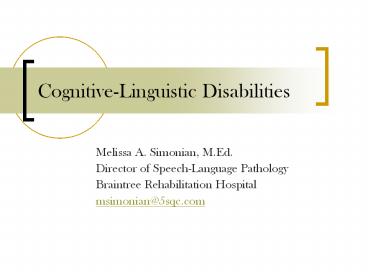Cognitive-Linguistic Disabilities - PowerPoint PPT Presentation
Title:
Cognitive-Linguistic Disabilities
Description:
Cognitive-Linguistic Disabilities Melissa A. Simonian, M.Ed. Director of Speech-Language Pathology Braintree Rehabilitation Hospital msimonian_at_5sqc.com – PowerPoint PPT presentation
Number of Views:248
Avg rating:3.0/5.0
Title: Cognitive-Linguistic Disabilities
1
Cognitive-Linguistic Disabilities
- Melissa A. Simonian, M.Ed.
- Director of Speech-Language Pathology
- Braintree Rehabilitation Hospital
- msimonian_at_5sqc.com
2
Communication Disabilities
- Approximately 49 million Americans live with a
communication disability.
3
(No Transcript)
4
Map of the proportionate association of the
cortex (part of the brain responsible for motor
and sensory info) with the body member and the
motor map of contralateral side of the body.
5
Changes after Frontal Lobe Damage
- Difficulty sequencing
- Perseveration
- Decreased attention
- Change in personality
- Decreased mental flexibility
- Difficulty with problem solving
- Limited initiation
- Emotional lability
6
Changes after Occipital Lobe Damage
- Visual deficits (i.e. field cut)
- Limited processing of visual information
- Difficulty reading and writing
7
Changes after Temporal Lobe Damage
- Difficulty understanding spoken words
- Difficulty with attention
- Decreased short term memory
- Difficulty identifying objects
- Meaningless speech
8
Changes after Parietal Lobe Damage
- Difficulty naming objects
- R/L confusion
- Decreased attention
- Impaired spatial orientation
9
Changes after Cerebellum Damage
- Poor motor coordination
- Impaired gross/fine motor coordination
- Slurred speech (Dysarthria)
10
Changes after Brain Stem Damage
- Difficulty swallowing (Dysphagia)
- Balance disorder
- Vertigo
- Impaired sleep/wake cycle
11
Causes
- Cerebrovascular Accident (CVA (Stroke))
- Traumatic Brain Injury (TBI, CHI)
- Progressive Neurologic Disease (PD, AD, ALS, MS)
12
Incidence of Adult onset Brain Disorders in the US
- Diagnosis
- CVA
- Alzheimers Disease
- Traumatic Brain Injury
- Parkinsons Disease
- Spinal Cord Injury
- Annually
- 600,000
- 350,000
- 1.4 million
- 550,000
- 11,000
13
Aphasia
- A failure to understand and/or produce language
- Primary Cause L-CVA
- Incidence over 1 million people living in the US
with Aphasia
14
Right Hemisphere Syndrome
- Cognitive, Visual, Communication, Emotional
difficulties - Primary Cause TBI, CHI, R-CVA
- 5 million living with a disability relating to an
acquired brain injury
15
Dementia
- Progressive decline in cognitive function due to
damage or disease in the brain beyond what might
be expected for normal aging - Cause Unknown
- Incidence 1 in 10 adults over 65 y/o
- 4 million currently living with the disease
16
Motor Speech Disorders
- Dysarthria A group of neurologic speech
disorders resulting from abnormalities in the
strength, speed, range, steadiness, tone or
accuracy of movements required for control of the
respiratory, phonatory, resonatory, articulatory,
and prosodic aspects of speech production.
- Apraxia A neurologic speech disorder reflecting
an impaired capacity to plan or program
sensorimotor commands necessary for directing
movements that result in phonetically and
prosodically normal speech.
17
- Communication
- Impairmentshow to do
- they impede function?
18
- People with Aphasia primarily
- experience difficulty with
- Verbal Expression
- Auditory Comprehension
- Reading
- Writing
- Visual Acuity
19
- People with Right Hemisphere
- Dysfunction experience difficulty with
- Orientation
- Memory
- Attention
- Problem Solving
- Reasoning
- Judgment
- Visual acuity
20
- People with Motor Speech Disorders
- experience difficulty with speech
- intelligibility.
- Rate
- Vocal Quality
- Articulator Precision
- Respiratory Coordination
21
- Assistive Technology for people with
- communication disabilities may be
- referred to in the literature as
- Augmentative/Alternative
- Communication (AAC)
22
Technology
- The increasing use of technology to help
- individuals compensate for cognitive-
- linguistic impairments is the most
- notable advance in neuro rehabilitation in
- recent years.
23
Success ?
- The most important predictor of long term
- success with assistive technology is
- careful selection of external aides to
- ensure they are well matched to the user
- and their environment.
- (Scherer et al.)
24
Tools for Selection
- Matching Person and Technology Assessment (MPT
Scherer, M. et al. Disability and Rehabilitation
Assistive Technology 2 (1) 1-8. 2007) - TechMatch (www.coglink.com/techmatch)
- Compensation Techniques Questionnaire (CTQ)
(Sohlberg and Turkstra in press)
25
Individual Needs Assessment
- Cognitive-Linguistic Profile
- Physical abilities
- Personal and Caregiver goals
- Preferences for tool use
- Financial resources
- Client motivation
26
Currently Available
- Low Tech
- High (er) Tech Smartphone, Ipad, GPS, Data
Watches, Chattervox, - Auto Med, Lifeline
- AAC Companies Tobii, Lingraphica, Dynovox
- Is there an app for that?
- (ie proloquo2go, assistivechat)
27
Technology needs to be
- Usable (easy)
- Adaptable (people change)
- Affordable (health insurance often does not cover
the cost of the device may incur cost of
evaluation and treatment to learn the device).
28
Disability
- Does not distinguish by race, creed, education
level, geographic location, or financial status. - May be physical, cognitive-linguistic or both
- May be sudden or gradual
- May happen to anyone at any time
- May be short term or long term
- May be overcomewith assistance
29
References
- Brain Based Communication Disorders
- Leonard LaPoint et al. 2010
- Mobile Devices and Communication Apps AN
AAC-RERC White Paper. - The Rehabilitation Engineering Research
- Center on Communicate Enhancement
- (NIDDR Grant Supported) 2011
- American Speech-Language Hearing Association
www.ASHA.org - Disability and Rehabilitation Assistive
Technology - Mark Scherer et al. 2007
30
Q/A
31
Thank you!































